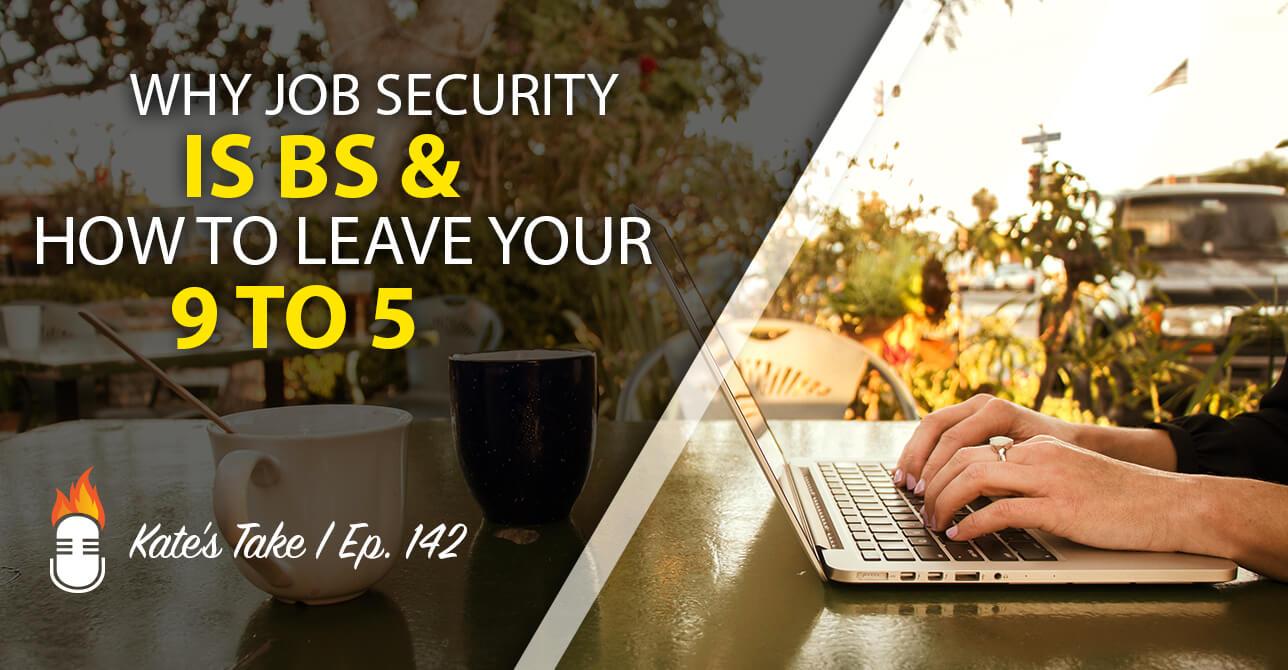 I got an email from an old friend a couple of weeks ago, asking how I was doing.
I got an email from an old friend a couple of weeks ago, asking how I was doing.
Why job security is BS (and how to leave your 9 to 5)
It wasn’t a long email – a couple of paragraphs catching me up on things that have been going on in her life.
She had a bit more to catch me on up on since we share more in common than most friends: we used to work together, too.
It was great to hear from her, I was excited to catch up, and before I even got to the end of the email I was already thinking about suggesting a time to meet up for lunch or coffee.
Then, I got to the end of the email.
“Oh – and I’m sure you’ve already heard: our department is being laid off at the end of the month.”
WHAT?!
Job security?
One of the biggest beliefs I struggled with in 2011 when I was thinking about leaving my 9 to 5 to start my own business was that starting my own business wasn’t secure.
I believed that because I was an employee, on someone else’s payroll, and receiving benefits that I had job security.
Taking my entrepreneurial leap meant giving all of that up – all of that “security” would be gone, and in its place would come a whole lot of uncertainty.
But where did that belief come from? Why did I believe a 9 to 5 could give me any more security than starting my own business could?
I literally believed that I was better off letting someone else determine and make decisions about my future than allowing myself to determine and make decisions about my future.
I should have known
That’s what society wanted me to believe – that it was more secure for me to let someone else determine and make decisions about my future.
And because I grew up believing a lot of what society told me, I went along with it. I 100% believed that starting my own business was the most “un-secure” move I could have made.
But looking back, I spent 3.5 years working in a department where it was my job to lay other employees off. Restructures, eliminations, reorganizations – whatever you want to call it, I felt secure in my job because I knew the layoffs weren’t going to stop any time soon.
Isn’t that ironic?
I should have known that being an employee, on payroll, and receiving benefits meant nothing when it came time for a department to be restructured, eliminated or reorganized.
Believing that I was better off letting someone else determine and make decisions about my future than allowing myself to determine and make decisions about my future was BS.
Note: I don’t think there’s anything wrong with having a corporate job. I do think there’s something wrong with not knowing or believing there’s another way IF you’re not passionate about – and do not enjoy – your job.
How to leave your 9 to 5
I remember it so clearly: the day I decided I would leave my 9 to 5.
It was in April of 2011, and I was just told that I wasn’t going to get a promotion I thought was in the bag.
What followed is what I like to refer to as the “3 phases”. These 3 phases allowed me to accomplish my goal of leaving my 9 to 5, and if they helped me without me even realizing that I was going through the phases, then I know they can help you.
Phase I: The decision
What was one of most painful corporate experiences of my life turned into the single most important corporate experience of my life: the one decision, event, ‘thing’ that pushed me over the edge.
Because of my missed promotion, I decided it was finally time to breakthrough my fears and leave the secure corporate world for the unknown world of entrepreneurship.
It was me actually declaring my decision – not just “thinking about it” – that made phase I a success.
Just thinking about it was certainly an integral step in the grand scheme of things, but until I had made the actual decision to do it, I wasn’t going to make any progress towards my goal of leaving.
If you’re currently working a 9 -to5, and you haven’t decided that leaving is right for you, then that’s okay. It’s not something that has to be rushed, and it might take experiencing something like I did for you to get that final push.
In any case, deciding you’re going to do it, and then actually doing it aren’t going to be simultaneous, so no need to feel a ton of pressure or stress around deciding you want to do it. You still have two phases to go.
Phase II: The preparation
Again, my leaving my 9 to 5 certainly didn’t happen overnight.
In fact, I didn’t leave my job until Oct 31, 2011, nearly 6 months after I decided I was going to do it.
I knew that there had to be some sort of preparation – not just me walking out the door that very same day. After all, at the time, I had no clue what type of business I wanted to start.
And so for the next 6 months, during my preparation period, I did the following:
1. Created a budget
For about 1 week, I started listing out all the financial responsibilities I had, in addition to all the things I was spending money on each week.
First, all the things I HAD to spend money on (rent, food, electricity), following by all the things I didn’t have to spend money on (going out to eat, Starbucks runs, a Saturday night out).
It was really the first time I had a clear picture of what I was spending money on that I didn’t have to be spending money on. I quickly realized exactly why I had $0 in savings.
I also wrote out every single debt I owed – credit cards, car payments, student loans – and I tallied up the total amount I would have to pay in order to get rid of all my debt.
2. Cracked down
Now that I had a clear picture of my financial situation, and exactly how much money I HAD to have in order to live, I cracked down.
I sacrificed my Starbucks run, I stopped eating out, and I politely declined nights out that didn’t have a significant meaning to me (i.e. a friend’s birthday or something like that).
I then created a savings account that was going to be for actual savings, and also a savings account that was going to be for paying off debt. With the amount of debt I owed, I calculated how many months it would take me to pay it all off if I was able to put every single extra penny I got each month towards it.
Not including my student loans, it was going to take me just one month (again, putting every extra penny I made towards my debt) to pay it all off.
3. Set a goal
Now that I knew exactly how much money I was making, exactly how long it would take me to pay off my debt, and exactly how much money I HAD to spend every month to live, I set my goal.
It was costing me about $2k to “live” every month, and with the plans I had set for the next 5-6 months, I added in an extra $500 / month (for travel, holidays, celebrations, etc).
My goal: leave my job with $10k in the bank.
Because of all the other numbers I had run, I figured out that it would take me 6 months to get there.
Phase III: The leap
Now that I had a S.M.A.R.T. goal set for when I was going to leave my 9 to 5, I could actually start planning for my leap.
What would I do once I left? What kind of business did I want to start?
I did some research online, and I also spent a lot of time thinking about what I loved doing, and also about what I had experience doing.
With these two lists, I came up with what I thought would be a viable business idea (check out that link if you want to get more in-depth on exactly what I did to figure this out).
Once I had my idea, I spent an hour every day when I got home from work researching my very next step.
I wasn’t researching things like “how to make money online”, or “how to get 10k email subscribers” – I was researching things like “how do I build a website”, and “what are the best ways to build an online presence”.
I focused on my very next step – not on my end goal of having a successful business (although my “why” and my end goal certainly helped me keep going when I wasn’t feeling very motivated, or when I didn’t feel like I was making much progress).
Everything in between
With everything I’ve covered throughout these 3 phases, it’s important to understand that everyone’s journey is unique, everyone’s budget will look different, and each situation might take longer (or less time) than what I’ve laid out here.
This is meant to be a framework you can use and adjust as necessary.
Will your S.M.A.R.T. goal be the same as mine? Probably not.
Will there be weeks when you second guess your decisions? I had them often.
Is it hard to make sacrifices while building your own dreams? Absolutely.
It’d be impossible for me to encompass it all in a post, which is why I’ve decided to keep it simple and straight to the point: once you make the decision to leave your 9 to 5 and you believe you can truly make it happen, all you need is a plan and the focus to implement it.
Do the work
Speaking of focus… while all 3 of these phases are incredibly important, Phase III was integral, because that was really the implementation stage for me.
I’d made my decision, and I had done all the prep to guide me in the right direction, but none of that would have mattered unless I was able to stay focused and do the work.
It was only a couple of weeks ago – when I received that email from my friend and old co-worker – that I realized what BS my whole belief about “job security” was.
Lucky for me, I didn’t have to go through being laid off, or having to scramble in order to figure out what I would do next.
So if you’re ready to make your own decision about what you want your life to look like – with the understanding that perhaps the most un-secure position you can be in is one where you rely on someone else to determine your future – then I hope the steps I’ve shared in this post and episode will be helpful for you.
